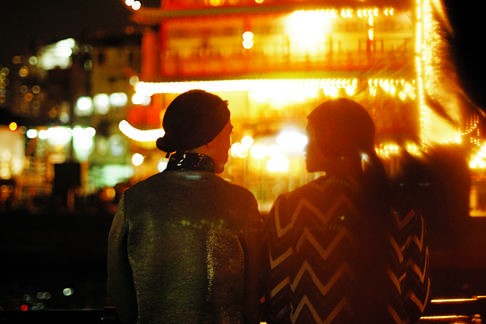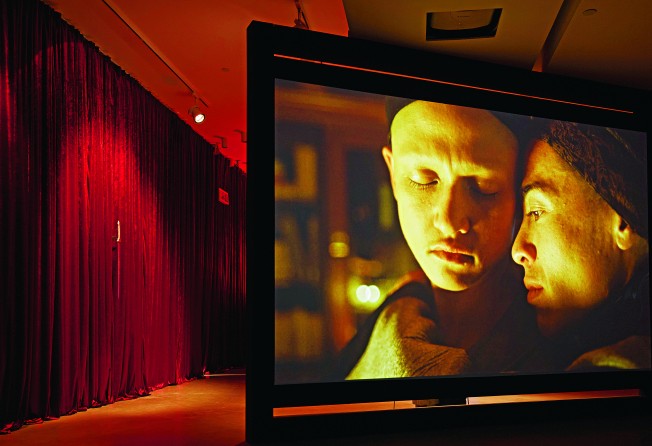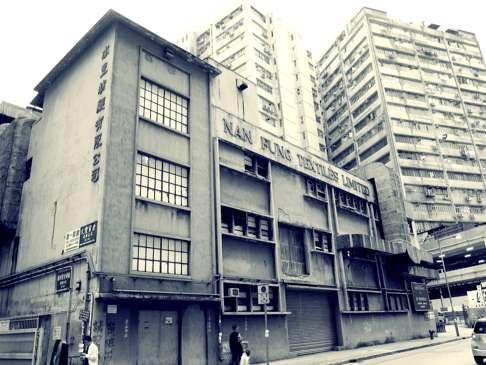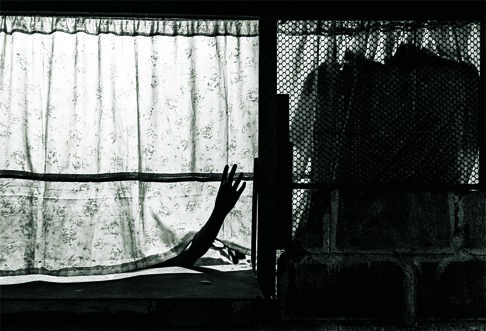
4 must-see free exhibitions that coincide with Art Basel Hong Kong 2016
A multimedia project about Chinese revolutionary Qiu Jin, and the stories of amahs and their modern-day counterparts, domestic helpers, are among shows art lovers shouldn’t miss next week

Call it Art Basel razzle dazzle. When Asia’s biggest contemporary art fair opens – it runs from March 24 to 26 at the Hong Kong Convention and Exhibition Centre – martinis will sprout elaborate decorations and shopping centres will pop with art. To navigate the maelstrom of cultural offerings, we’ve sifted through all of next week’s art openings and picked a few must-sees that are curated with conviction and free to see.

1. Duilian, Spring Workshop
The Chinese title of this film installation, Duilian, reflects two possible meanings: rhyming couplets, or a martial arts exercise for two. Both feature in this work by artist Wu Tsang, based on her decade of research into Qiu Jin, the Han Chinese revolutionary publicly beheaded by the Qing government in 1907.
For Tsang, an American transgender artist of mixed Chinese and Swedish parentage, patriotic heroine Qiu’s story is ripe for an alternative reading. Qiu’s personal life remains largely unexplored despite her fascinating identity: a mother, divorcee, poet and martial artist at a time when women were expected to stay quietly at home. The untold side of her story evokes all kinds of interesting dialogues about the fluidity of identities and language, Tsang says.
“When Qiu was executed, she was called a felon by the authorities. What we know about her will always be mediated by others,” she explains. The restoration of Qiu’s reputation was the life work of her close friend Wu Zhiying, a calligrapher who risked her own safety to give Qiu a proper burial.
In Tsang’s hands, that relationship became a timeless love story portrayed in a beautifully shot 27-minute film, the culmination of her six-month residency in Hong Kong. Not only does it challenge the implicit assumption of national heroes as heterosexual, the surreal images – including the women on a sampan in modern-day Aberdeen Harbour – add a layer of subversion. The now lesbian heroines are played by two trans people: Tsang, who identifies as a woman, and performance artist and long-time collaborator, boychild.
That Qiu could have been part of China’s unspoken queer history is one of the alternatives explored in the project, which is also about Tsang’s attempt to find her Chinese roots, a task made more difficult because she doesn’t know the language. In an exercise of “mistranslation”, she asks different communities to freely translate Qiu’s and Wu’s poems into their own languages (Cantonese, English, Malay and Tagalog), and these become the voice-over for the film. They can be hilarious; the women didn’t really write “karaoke with snot and tears”, for example. Interspersed between scenes, a group of Shanghai-based women martial artists engage in highly choreographed swordplay.
There are other works on show beside the film, including the paper effigy of Qiu and Wu that will feature in a special, combustible performance called Tears, Tears, Tears, on March 24, 12pm-1pm.
Duilian, Spring Workshop, 3/F Remex Centre, 42 Wong Chuk Hang Road, Aberdeen, Tue-Sun 12-6pm. Ends May 22.

2. Social Fabric: New Works by Mariana Hahn and Kwan Sheung-chi, MILL6 pop-up space
Social Fabric, curated by David Elliott, is the latest in a series of pre-opening exhibitions organised by the people in charge of Nan Fung Group’s ongoing conversion of an old Kowloon cotton mill into an art and textile heritage centre.
Their interest is in projects combining the two forms, literally and figuratively in this case.
German artist Mariana Hahn, MILL6 Foundation’s first artist-in-residence, and Hong Kong’s Kwan Sheung-chi will present new works that consider the loss and mutability of collective memory.
Kwan’s exhibition picks up from his 2012 work Hong Kong, a map of the city folded into a globe, and promises to be a sardonic view of daily life and what’s considered great art. Kwan prefers to keep his works under wrap until the opening.
But what’s known about Hahn’s part of the exhibition already makes a visit seem worthwhile. Her residency has focused on the story of the amahs – single women from Guangdong province who sought work as domestic helpers in Hong Kong, Macau and Southeast Asia for a few decades after the 1920s. In particular, she is gripped by the “Ma Jies” from the Shun Tak area, often silkworm breeders at home who wore their hair long and braided as a mark of their commitment to spinsterhood. There is much here that resonates with her body of work, which uses fabric as a motif representing the marks of history and personal narratives on the bodies of women.
The subject of amahs often receives dramatic treatment in Hong Kong for what they represent in the public imagination: independence, asceticism and loyalty, either towards each other or the families they serve. There is Anne Hui’s 2011 film, A Simple Life: The Amahs, a play in last year’s Hong Kong Arts Festival, and Intimates, Jacob Cheung Chi-leung’s 1997 film.
Hahn’s initial approach is no less romantic, seeing the amahs as an idealised sisterhood who turned their backs on conventional marriage, attaining financial independence and retiring, hermit-like, to religious establishments on Lantau Island and other remote parts of the New Territories. In their former lives as silkworm breeders, they would keep the worms warm close to their breasts, she says.
What prevents her first project in Asia from slipping into an Orientalist fantasy are elements of the absurd.
“I became a bit crazy trying to track them down on Lantau Island, where some still live, I’ve been told. I would run about in silk dresses, checking all the temples and asking the trees and the graves if they’d seen them. But I haven’t found them,” she says. All she discovered was an old Tanka fisherman in Tai O, who distracted her by teaching her how to make a fishing net. Captured on video, they made a faintly Odysseyan quest to the mouth of the Pearl River, in search of revelation regarding Hong Kong’s heritage. The water looked pretty polluted, the whole delta dystopian, but it led to ponderings about water’s ability to retain memory – a phenomenon German scientists proved in 2011.
Considering her experience, the exhibition is by no means cynical, and contains installations that are poetic tributes to her journey in Hong Kong. There are 10 silk dresses soaked in sea water, which will have crystallised by the time the exhibition opens. There is a fishing rod hanging over a large, blue salt circle that is kept damp so that the crystals will continue to grow.
“I didn’t find what I wanted to find, but perhaps I found what I needed to find,” she says.
Social Fabric, MILL6 Pop-up Space, The Annex, 2/F, Nan Fung Place, 173 Des Voeux Road Central, Mon-Sat 11am-7pm, March 22-April 21.

3. Afterwork, Para Site
This is a group show about today’s amahs – domestic helpers from the Philippines and Indonesia who are so much part of Hong Kong’s social fabric. More than 30 artists are represented in this exhibition, but two names in particular give a sense of the amount of ground the curators want to cover: Xyza Cruz Bacani and Larry Feign. The former represents new hope, a young live-in Filipino helper whose powerful black-and-white photography was discovered and won her a scholarship to study in New York. Feign’s No Dogs, Rats, Roaches or Filipinas is a scathing commentary on racism in Hong Kong that is as valid today as it was when the cartoon was published in the South China Morning Post in 1994.

The exhibition is part of Para Site’s ongoing Hong Kong migrant domestic workers project, which runs public programmes and commissions artistic research. Part of Afterwork will be an anthology of migrant and domestic worker literature, conceived with the help of Indonesia’s KUNCI Cultural Studies Centre, being published in Bahasa Indonesia, Chinese, English and Tagalog.
Afterwork, Para Site, 22/F, Wing Wah Industrial Building, 677 King’s Road, Quarry Bay, Wed-Sun, 12pm-7pm, Mar 19-May 29.
4. Digging a Hole in China, OCAT Shenzhen
Although this one takes more effort to get to, its ambition deserves a trip to the other side of the border.
Curated by Hongkonger Venus Lau, who has become a major player in China’s art world, the show aims to challenge how we see contemporary Chinese art.
Works by 12 artists examine the discrepancy between land art - works created using a site’s natural landscape - in China and the concept’s original manifestations in the West. Massive outdoor undertakings such as Robert Smithson’s Spiral Jetty – in the middle of nowhere, in Utah – were often acts of protest against the capitalistic art market, rampant industrialisation and other “forces of evil”. In China, what’s considered land art comes from a very different context, she says, and the show aims to convince viewers that not all Chinese contemporary art is derived from the West.
“Land here is an administrative concept since nobody owns land, and so-called land art usually deals with China’s current urbanisation. It is more intimate than in the West. Also, Western land art was a protest and escape, but Chinese artists would make art in remote places in the past because they didn’t have a choice, because contemporary art was still outlawed up to the 1990s,” Lau adds.
Digging a Hole in China, Exhibition Hall A, OCT Contemporary Art Terminal, OCT Loft, Enping Street, Nanshan, Shenzhen, Tuesday-Sunday, 10am-5.30pm. Mar 20 - Jun 26.
There are a number of other great shows on, including the M+ Sigg Collection Exhibition at Artistree in Quarry Bay, which is not included here because it opened in February, Hack Space at the K11 Art Foundation’s pop-up space in Sheung Wan, and “Apparatus of Power”, Shahzia Sikander’s solo exhibition at the Asia Society. Please check scmp.com/topics/art-basel-2016 for the latest from Hong Kong art week.